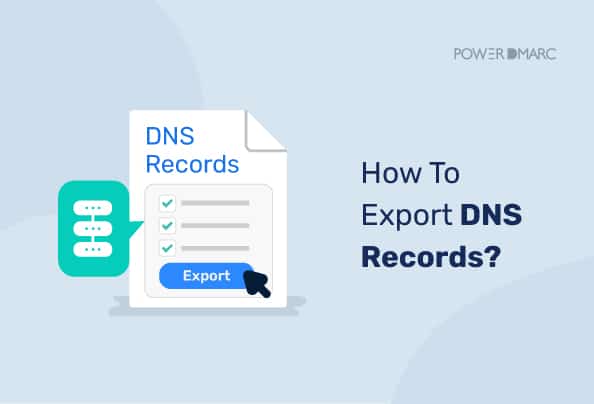It’s important to understand the concept of DNS records to use email authentication protocols like SPF, DKIM and DMARC. You’ve to export DNS records to save a local copy of your zone file. DNS records consist of data stored in your domain’s database and can help you gain useful information about your domain’s resources.
What is a DNS Record?
DNS is short for Domain Name System, and a DNS record includes instructions contained in an authoritative DNS server to offer domain details. You can see the domains and their corresponding IP addresses and also direct how all the requests should be managed and handled.
It is crucial to know how to export DNS records because it has a cluster of sequential text files coded in DNS syntax. DNS syntax is a chain of characters used as instructions for a DNS server. There are various kinds of DNS records, and each has its own TTL or time-to-live that tells the period when a packet or data expires.
DNS records are specific resource records stored in a DNS database that lets you align and control other details about a domain. You can configure it to specify what type of mail server your domain uses or which IP address should be returned if a user tries navigating your website. These are categorically arranged into zones corresponding to one or more domains under your control. So, if you’ve sample.com and sample2.com domain names, there will be two independent sets of DNS records for each.
What are the Common Types of DNS Records?
Before knowing how to export DNS records for domain, let’s check out the common types of records.
A Record
An A Record specifies an IP address for a particular website or domain name. It’s used for Ip address lookups, and that’s how a web browser loads a webpage using the domain name. Hence, we can visit websites we want to despite having no clue about the IP addresses.
A Records are also used for the blackhole list based on DNS. This is acronymized as DNSBL
AAAA Record
AAAA records are used in the IPv6 protocol, where they assign IPv6 addresses to hosts on the internet. This can be done for an IPv6 address to a hostanme or a hostname to an IPv6 address.
That’s why AAAA records are helpful for network administrators who want to assign their devices with custom IPv6 addresses with no restrictions on the long strings of numbers.
CNAME Record
This DNS record type creates aliases for your domain. Suppose, if you’ve a website at www.sample.com, you can use a CNAME record to establish an alias such that if anyone on the internet navigates ir, they’ll be taken to blog.sample.com and not to the root domain.
It also sets up redirects between various versions of your website or application or between different subdomains of the same root domain.
Nameserver (NS) Record
This DNS record type seeks nameservers for a domain and is added to the zone file if you align a new domain with your main account. It should be set up rightly before generating other records for that domain.
The purpose of the NS records is to specify the nameservers used by you on the internet. This becomes a crucial part of all DNS configuration process. It helps users reach their destination on the internet by giving an authoritative source for DNS information.
Mail Exchange (MX) Record
An MX record tells the mail servers that accept emails sent to a particular domain name. This is essential when you’ve to receive email through your domain and points to an A record or AAAA record.
TXT Record
This DNS record type allows you to enter extra information about your domain in a textual format. This is generally seen in email authentication practices like DMARC. It’s responsible for instructing the receiving server on how to validate the mail servers’ source information. The elementary method used by email servers to show an email’s validity is through SPF TXT record.
Common Use Case For Exporting DNS Records
The biggest advantage to export DNS records is that it creates backups for your current configurations. It also helps in cloning records for use on other nameservers.
To export DNS records for domain, you’ve to add a minimum of one domain in your DNS.
How To Export DNS Records?
To export DNS records, you need to visit the official platform of your DNS management service and tool provider. Sign in and follow the steps below:
STEP 1: Navigate to Managed DNS
Login to the dashboard and select Managed DNS from the DNS menu. You’ll find this option on the top right of the navigation.
STEP 2: Choose the Domain You Have to Export Records For
Enter the domain name or select it from the Recently Updated Domains list. Click on See All to check all the domains in your account.
STEP 3: Navigate to Reporting
Once you have clicked on the appropriate domain, you will be on the domain’s record page. Here, you’ve to select the Reporting tab.
STEP 4: Select File Type and Export
In the last step, choose the file type you want and then click Export. This will successfully export DNS record.
Check your DNS records with PowerDMARC
If you are still unsure about your domain’s DNS records, you can perform a DNS check with PowerDMARC. This will help you view the DNS record syntaxes for all types of records configured for your domain, and troubleshoot errors faster. For further assistance, contact us today!
- Email Safety 101 to Fight Crypto Scams - April 30, 2024
- How to Find the Best DMARC Solution Provider for Your Business? - April 25, 2024
- PowerDMARC and Zendata Forge Partnership to Enhance Domain Security - April 25, 2024
